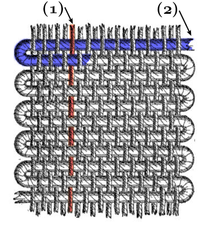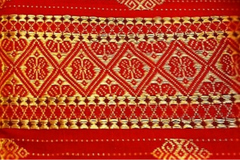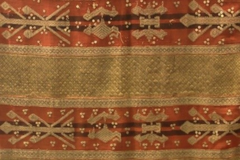Understanding Handwoven Fabric and Its Benefits
In a world where sustainability is a hot topic and a way of life, understanding handwoven fabrics isn't just about beauty, it's a step towards mindful consumption. Handwoven fabrics, often overshadowed by fast fashion, are the real eco-friendly winners. They carry on a tradition of skill, a personal touch, and a deep connection with the environment. Let's explore why handwoven fabrics matter and their benefits.
What is Handwoven Fabric?

Woven fabric, known as "kain tenun," is crafted from yarn spun using specialized tools by hand. The yarn, derived from materials such as cotton, wood, silk, and more, is carefully spun by combining longitudinal (1: warp / "lungsin") and transverse (2: weft / "pakan") threads (Photo source: wikipedia). Handwoven fabrics usually have their patterns or motifs set before the yarn is spun. The variety of woven fabric designs shows where it comes from and the cultural and environmental influences behind them.
Handwoven fabrics bring a special touch with their unique features, unlike machine-made ones. The visible irregularities are not flaws but show the “human touch” in crafting.
Weaving, an ancient art, has been for centuries, even before the BC. The labor-intensive process and traditional wisdom handed down through generations give them values beyond just function.
Benefits of Handwoven Fabric
Handwoven fabric is great for so many reasons - it's durable, stylish, and eco-friendly! Check out these awesome benefits that make handwoven fabric stand out:
Durability and Longevity
The weaving process, where the warp and weft threads are tightly interlocked, makes handwoven fabric stronger and more durable. This is why handwoven fabric is great for various everyday products, including clothing and household furniture / interior design. In addition, handwoven fabric doesn't stretch easily, making it the best choice for garments or products that need to maintain their shape. It's no surprise that handwoven pieces are frequently passed down through generations.
Cool and Breathable
The use of natural fibers in handwoven fabric enhances its breathability and coolness, which is perfect for warm weather or any climate. This unique property keeps the wearer comfortable without trapping heat or moisture, as can often be the case with synthetic options. Additionally, handwoven fabric feels comfortable against the skin and is suitable for everyday clothing.
A Symbol of Heritage and Tradition

Handwoven textiles represent the age-old traditions of the communities that produce them. By purchasing and wearing handwoven fabric, individuals not only support the continuation of these crafts but also the preservation of cultural heritage and individual craftsmanship, ensuring that these skills continue to be practiced and valued.
Sustainability and Eco-Friendliness
The creation of handwoven fabric is a low-impact process, especially when compared to the energy consumption and waste production associated with industrial weaving.
The process of handweaving typically utilizes natural fibers that are biodegradable and renewable. In contrast, synthetic fibers can take hundreds of years to decompose, contributing to landfill overflow and environmental degradation.
Additionally, locally sourced and sustainable fibers contribute to a smaller carbon footprint.
Unique Texture and Designs
Hand-looming offers fabric designers and those who work with handwoven textiles an enormous playground for creativity. The process allows for a variety of unique textures, patterns, and color combinations, depending on the loom setup, materials used, and dyeing process, that are not easily achievable with mechanical weaving techniques. The woven fabric pattern is a characteristic feature of a region and ethnic identity.
For example, here in Indonesia, we have various local handwoven fabrics originating from regions across Indonesia, such as the following:
|
Tenun Pandai Sikek from Minangkabau |
Kain Tapis from Lampung | Tenun Baduy from Baduy Tribe |
 |
 |
 |
Source: Indonesiakaya.com
Exclusive Aesthetic
No two handwoven pieces are exactly alike. The individuality in their weaves, patterns, and colors guarantees that each textile is unique. This aspect of exclusivity is a draw for those who seek distinct items for their wardrobes or homes.
Supporting Artisans and Local Communities
Purchasing handwoven fabric directly supports local artisans, especially in regions where traditional weaving is a primary source of income. Fair trade practices and a transparent supply chain ensure that these skilled workers receive fair compensation for their craft.
In summary of today’s article, handwoven fabric stands as a tangible representation of a cultural narrative, an eco-conscious attitude, and a standard of quality that deeply connects with those seeking value and authenticity. Whether it's to enliven your personal style, enrich your living space, or contribute to the sustaining of tradition, the benefits of handwoven fabrics are as vast as the range of experiences they provide.
Have a look your first handwoven fashion!
 |
 |
 |
| Bakung Handwoven Cotton Ikat Wrap Belt in Yellow | Magnolia Natural Pineapple Fiber Silk Shawl for Women | Bakung Handspun Cotton Ikat Wrap Waist Sash in Deep Pink |
